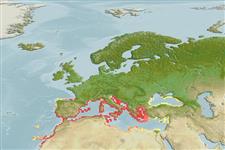Environment: milieu / climate zone / djupintervall / distribution range
Ekologi
marina; sötvatten; brackvatten pelagic-neritic. Subtropical; 45°N - 25°N, 20°W - 45°E
Eastern Atlantic: coasts of Spain and Morocco including Madeira and the Canary Islands. Also in the western Mediterranean, Adriatic Sea and Black Sea.
Size / Vikt / Age
Könsmognad: Lm ? range ? - ? cm
Max length : 20.0 cm TL hane/ej könsbestämd; (Ref. 5980); common length : 15.0 cm TL hane/ej könsbestämd; (Ref. 5980)
Short description
Bestämningsnycklar | Morfologi | Morfometri
Total scales in midlateral series 59-65. Anal fin with 10-12 1/2 rays (Ref. 59043).
Body shape (shape guide): elongated.
Littoral, often near shore. Gregarious, sometimes occurs in marine lagoons (France) and estuaries (Portugal). Feed on pelagic copepods and benthic crustaceans (Ref. 5980).
Life cycle and mating behavior
Könsmognad | Reproduktion | Lek | Ägg | Fecundity | Larver
Maugé, L.A., 1990. Atherinidae. p. 604-605. In J.C. Quero, J.C. Hureau, C. Karrer, A. Post and L. Saldanha (eds.) Check-list of the fishes of the eastern tropical Atlantic (CLOFETA). JNICT, Lisbon; SEI, Paris; and UNESCO, Paris. Vol. 2. (Ref. 4499)
IUCN Red List Status (Ref. 130435: Version 2025-1)
Threat to humans
Harmless
Human uses
Fiskeri: kommersiellt viktig
Verktyg
Special reports
Download XML
Internet-källor
Estimates based on models
Preferred temperature (Ref.
123201): 16.1 - 21.1, mean 19 °C (based on 523 cells).
Phylogenetic diversity index (Ref.
82804): PD
50 = 0.5312 [Uniqueness, from 0.5 = low to 2.0 = high].
Bayesian length-weight: a=0.00550 (0.00431 - 0.00701), b=3.08 (3.01 - 3.15), in cm total length, based on LWR estimates for this species (Ref.
93245).
Trofisk nivå (Ref.
69278): 3.2 ±0.33 se; based on food items.
Resiliens (Ref.
120179): Mellan, lägsta populationsfördubblingstid 1,4-4,4 år (Preliminary K or Fecundity.).
Fishing Vulnerability (Ref.
59153): Low vulnerability (10 of 100).
🛈
Nutrients (Ref.
124155): Calcium = 130 [79, 276] mg/100g; Iron = 1.31 [0.75, 2.20] mg/100g; Protein = 20.8 [19.3, 22.2] %; Omega3 = 0.379 [0.190, 0.732] g/100g; Selenium = 11.5 [5.3, 25.4] μg/100g; VitaminA = 24.7 [8.7, 69.4] μg/100g; Zinc = 1.45 [1.02, 2.08] mg/100g (wet weight);
